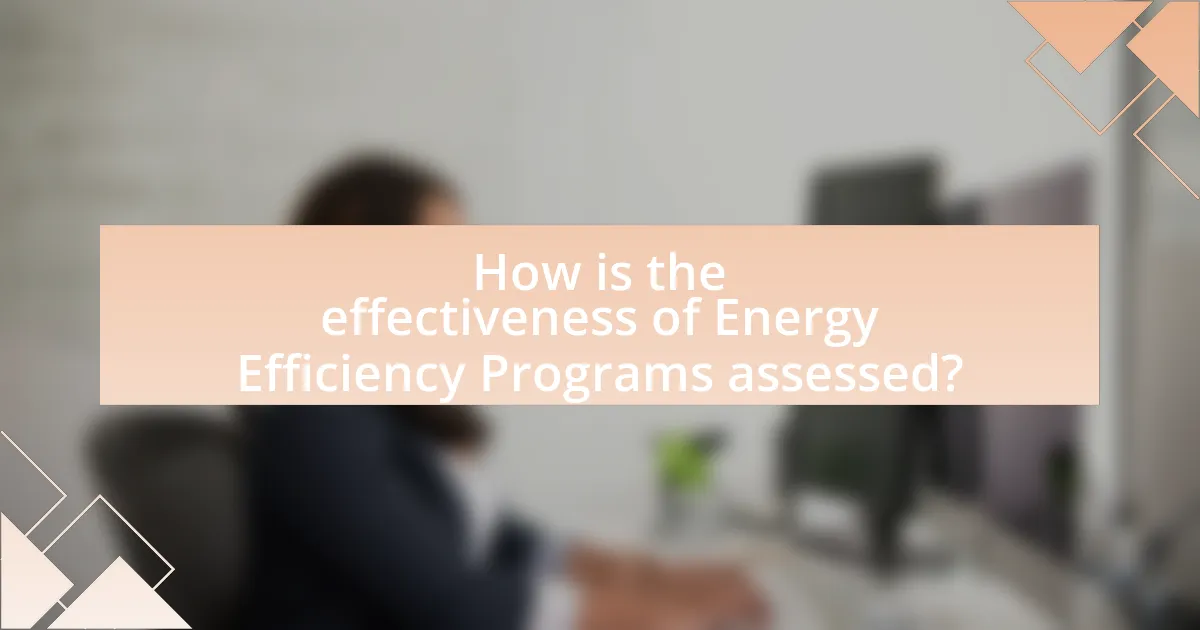Energy Efficiency Programs are structured initiatives aimed at reducing energy consumption while maintaining service levels, often through financial incentives and educational outreach. These programs encompass key components such as energy audits, incentive structures, and technology upgrades, which collectively enhance their effectiveness in promoting sustainable energy use. The article evaluates the goals, functioning, and assessment metrics of these programs, highlighting their potential to achieve significant energy savings and environmental benefits. Additionally, it addresses challenges in measuring effectiveness and offers best practices for improving program outcomes through stakeholder engagement and innovative approaches.

What are Energy Efficiency Programs?
Energy Efficiency Programs are initiatives designed to promote the reduction of energy consumption while maintaining the same level of service or output. These programs often include incentives for consumers and businesses to adopt energy-saving technologies, such as energy-efficient appliances, lighting, and HVAC systems. According to the U.S. Department of Energy, energy efficiency improvements can lead to significant reductions in energy use, with potential savings of up to 30% in residential and commercial sectors.
How do Energy Efficiency Programs function?
Energy Efficiency Programs function by implementing strategies and initiatives designed to reduce energy consumption while maintaining the same level of service. These programs typically involve financial incentives, such as rebates or tax credits, to encourage individuals and businesses to adopt energy-efficient technologies and practices. For example, the U.S. Department of Energy reports that energy efficiency measures can lead to significant reductions in energy use, with some programs achieving savings of up to 30% in energy consumption. Additionally, these programs often include educational components to raise awareness about energy-saving practices, further enhancing their effectiveness in promoting sustainable energy use.
What are the key components of Energy Efficiency Programs?
The key components of Energy Efficiency Programs include energy audits, incentive structures, education and outreach, technology upgrades, and performance measurement. Energy audits assess current energy usage and identify opportunities for savings, while incentive structures provide financial motivation for participants to adopt energy-efficient practices. Education and outreach efforts inform consumers about the benefits of energy efficiency, and technology upgrades involve the installation of energy-saving equipment. Performance measurement tracks the effectiveness of these programs, ensuring that energy savings are realized and reported accurately. These components collectively contribute to the overall success and effectiveness of Energy Efficiency Programs.
How do these components interact to promote energy efficiency?
Energy efficiency components interact through a synergistic relationship that optimizes resource use and minimizes waste. For instance, advanced technologies such as smart meters and energy-efficient appliances work together to provide real-time data and automate energy consumption, leading to reduced energy use. Additionally, building insulation and HVAC systems collaborate to maintain optimal temperatures with less energy expenditure. Studies show that implementing these integrated systems can lead to energy savings of up to 30%, as reported by the U.S. Department of Energy. This interaction not only enhances performance but also contributes to significant cost savings and environmental benefits.
What are the goals of Energy Efficiency Programs?
The goals of Energy Efficiency Programs are to reduce energy consumption, lower utility costs, and decrease greenhouse gas emissions. These programs aim to promote the use of energy-efficient technologies and practices among consumers and businesses, thereby enhancing overall energy performance. For instance, the U.S. Department of Energy reports that energy efficiency improvements can lead to significant savings on energy bills, with potential reductions of up to 30% in energy use. Additionally, these programs contribute to environmental sustainability by mitigating climate change impacts through reduced fossil fuel reliance.
How do Energy Efficiency Programs aim to reduce energy consumption?
Energy Efficiency Programs aim to reduce energy consumption by promoting the use of technologies and practices that require less energy to perform the same tasks. These programs often include incentives for upgrading to energy-efficient appliances, implementing better insulation, and utilizing smart energy management systems. For example, the U.S. Department of Energy reports that energy efficiency improvements can lead to a reduction in energy use by up to 30% in residential buildings. By providing financial rebates and educational resources, these programs encourage consumers and businesses to adopt energy-saving measures, ultimately leading to lower overall energy demand and reduced greenhouse gas emissions.
What environmental benefits are associated with Energy Efficiency Programs?
Energy Efficiency Programs provide significant environmental benefits by reducing energy consumption, which in turn lowers greenhouse gas emissions. For instance, according to the U.S. Environmental Protection Agency, energy efficiency improvements can reduce carbon dioxide emissions by up to 30% in buildings, contributing to cleaner air and mitigating climate change. Additionally, these programs help decrease the demand for fossil fuels, leading to less habitat destruction and pollution associated with energy extraction and production. By promoting the use of energy-efficient technologies, these programs also support sustainable resource management, ultimately fostering a healthier ecosystem.

How is the effectiveness of Energy Efficiency Programs assessed?
The effectiveness of Energy Efficiency Programs is assessed through a combination of quantitative metrics and qualitative evaluations. These assessments typically involve measuring energy savings, cost-effectiveness, participant satisfaction, and environmental impact. For instance, energy savings are often quantified using baseline energy consumption data compared to post-implementation usage, allowing for a clear calculation of reduced energy demand. Additionally, cost-effectiveness is evaluated by analyzing the ratio of program costs to the energy savings achieved, often expressed in terms of cost per kilowatt-hour saved. Studies, such as those conducted by the American Council for an Energy-Efficient Economy, provide empirical evidence supporting these assessment methods, demonstrating that well-implemented programs can lead to significant reductions in energy consumption and greenhouse gas emissions.
What metrics are used to evaluate Energy Efficiency Programs?
Energy efficiency programs are evaluated using metrics such as energy savings, cost-effectiveness, participant satisfaction, and environmental impact. Energy savings is quantified in kilowatt-hours (kWh) or therms saved, providing a direct measure of the program’s effectiveness in reducing energy consumption. Cost-effectiveness is assessed through the ratio of benefits to costs, often expressed as the Total Resource Cost (TRC) test, which compares the costs of implementing the program against the savings generated. Participant satisfaction is measured through surveys and feedback, indicating the perceived value and effectiveness of the program. Environmental impact is evaluated by calculating the reduction in greenhouse gas emissions resulting from energy savings, often using established conversion factors to quantify the benefits. These metrics collectively provide a comprehensive assessment of the effectiveness of energy efficiency programs.
How do energy savings measurements contribute to effectiveness assessments?
Energy savings measurements are critical for effectiveness assessments as they provide quantifiable data that reflects the actual impact of energy efficiency programs. By measuring the reduction in energy consumption, stakeholders can evaluate whether the implemented strategies are achieving their intended goals. For instance, a study by the American Council for an Energy-Efficient Economy found that programs with robust energy savings measurements reported a 20% higher success rate in achieving energy reduction targets compared to those without such measurements. This data-driven approach allows for informed decision-making, enabling program adjustments and improvements based on empirical evidence.
What role do participant surveys play in evaluating program success?
Participant surveys are essential tools for evaluating program success as they provide direct feedback from participants regarding their experiences and outcomes. These surveys gather quantitative and qualitative data that reflect participant satisfaction, perceived benefits, and areas for improvement. For instance, a study by the American Council for an Energy-Efficient Economy found that participant feedback significantly correlates with program effectiveness, indicating that programs with higher satisfaction ratings often achieve better energy savings. This data helps program administrators make informed decisions to enhance program design and implementation, ultimately leading to improved energy efficiency outcomes.
What challenges exist in assessing the effectiveness of Energy Efficiency Programs?
Assessing the effectiveness of Energy Efficiency Programs faces several challenges, including the difficulty in quantifying energy savings, the variability in program implementation, and the lack of standardized evaluation methods. Quantifying energy savings is complex due to factors such as behavioral changes and external influences that can affect energy consumption patterns, making it hard to isolate the impact of the program. Variability in program implementation can lead to inconsistent results, as different regions or organizations may apply different strategies or technologies. Additionally, the absence of standardized evaluation methods complicates comparisons across programs, hindering the ability to draw general conclusions about effectiveness. These challenges are supported by findings from the American Council for an Energy-Efficient Economy, which highlights the need for robust evaluation frameworks to accurately measure program impacts.
How do external factors influence the assessment of program effectiveness?
External factors significantly influence the assessment of program effectiveness by shaping the context in which programs operate. These factors include economic conditions, regulatory environments, social norms, and technological advancements, all of which can impact program outcomes and stakeholder perceptions. For instance, a study by the American Council for an Energy-Efficient Economy (ACEEE) found that economic downturns can reduce energy consumption, thereby affecting the perceived effectiveness of energy efficiency programs. Additionally, changes in regulations can either enhance or hinder program implementation, as seen in California’s energy efficiency initiatives, which have been bolstered by supportive policies. Thus, understanding these external influences is crucial for accurately evaluating program effectiveness.
What are common pitfalls in measuring program outcomes?
Common pitfalls in measuring program outcomes include inadequate data collection, lack of clear objectives, and failure to account for external factors. Inadequate data collection can lead to incomplete or biased results, making it difficult to assess the true impact of energy efficiency programs. A lack of clear objectives results in ambiguous outcomes, hindering the ability to measure success effectively. Additionally, failing to account for external factors, such as economic conditions or changes in technology, can skew results and misrepresent the program’s effectiveness. These pitfalls can compromise the validity of the evaluation and lead to misguided conclusions about program performance.

What are the best practices for improving Energy Efficiency Programs?
The best practices for improving Energy Efficiency Programs include conducting thorough energy audits, implementing targeted outreach and education initiatives, and utilizing data analytics for continuous improvement. Energy audits identify specific areas for efficiency gains, allowing programs to focus on high-impact interventions. Targeted outreach ensures that information reaches the appropriate audiences, increasing participation rates. Data analytics enables program managers to track performance metrics and adjust strategies based on real-time feedback, leading to more effective outcomes. These practices are supported by studies showing that programs employing comprehensive audits and data-driven approaches achieve up to 30% greater energy savings compared to those that do not.
How can stakeholder engagement enhance program effectiveness?
Stakeholder engagement enhances program effectiveness by fostering collaboration, ensuring diverse perspectives, and increasing buy-in for energy efficiency initiatives. Engaging stakeholders, such as community members, businesses, and government entities, allows for the identification of specific needs and barriers, leading to tailored solutions that are more likely to succeed. Research indicates that programs with active stakeholder involvement can achieve up to 30% higher participation rates, as stakeholders help to promote initiatives and encourage others to join. This collaborative approach not only improves program design but also enhances trust and accountability, ultimately resulting in more effective energy efficiency outcomes.
What strategies can be employed to increase participant involvement?
To increase participant involvement in energy efficiency programs, strategies such as providing incentives, enhancing communication, and fostering community engagement can be employed. Incentives, such as rebates or discounts, motivate participants to engage actively; for instance, a study by the American Council for an Energy-Efficient Economy found that financial incentives can increase participation rates by up to 50%. Enhancing communication through targeted outreach and educational materials ensures that participants understand the benefits and processes involved, which can lead to higher engagement levels. Additionally, fostering community engagement through local events or partnerships with community organizations creates a sense of ownership and encourages participation, as evidenced by successful programs that have utilized local networks to boost involvement.
How does collaboration with local governments impact program success?
Collaboration with local governments significantly enhances the success of energy efficiency programs by ensuring alignment with community needs and regulatory frameworks. Local governments possess unique insights into the specific challenges and opportunities within their jurisdictions, which can inform program design and implementation. For instance, a study by the American Council for an Energy-Efficient Economy (ACEEE) found that programs involving local government partnerships achieved 20-30% higher energy savings compared to those without such collaboration. This increase is attributed to improved outreach, tailored incentives, and streamlined permitting processes that local governments can facilitate.
What innovative approaches can be adopted for Energy Efficiency Programs?
Innovative approaches for Energy Efficiency Programs include the integration of smart technology, such as IoT devices, to monitor and optimize energy usage in real-time. These technologies enable precise tracking of energy consumption patterns, allowing for targeted interventions that can lead to significant reductions in energy waste. For instance, a study by the American Council for an Energy-Efficient Economy (ACEEE) found that smart thermostats can reduce heating and cooling costs by up to 10-15%. Additionally, implementing behavioral nudges, such as feedback on energy usage compared to peers, has been shown to encourage energy-saving behaviors, resulting in an average reduction of 5-15% in energy consumption. These approaches demonstrate the potential for enhanced effectiveness in energy efficiency initiatives through technology and behavioral insights.
How can technology be leveraged to improve program outcomes?
Technology can be leveraged to improve program outcomes by utilizing data analytics and smart monitoring systems to enhance energy efficiency programs. These tools enable real-time tracking of energy consumption, allowing for timely adjustments and targeted interventions. For instance, a study by the American Council for an Energy-Efficient Economy found that programs incorporating advanced metering infrastructure can achieve energy savings of up to 20% compared to traditional methods. Additionally, machine learning algorithms can analyze historical data to predict energy usage patterns, facilitating more effective resource allocation and program design.
What role does data analytics play in refining Energy Efficiency Programs?
Data analytics plays a crucial role in refining Energy Efficiency Programs by enabling the identification of patterns and trends in energy consumption data. This analytical approach allows program managers to assess the effectiveness of various initiatives, optimize resource allocation, and tailor interventions to specific user behaviors. For instance, a study by the American Council for an Energy-Efficient Economy found that data-driven insights can lead to a 10-30% increase in energy savings by targeting the most inefficient practices. By leveraging data analytics, organizations can continuously improve program design and implementation, ensuring that energy efficiency efforts yield maximum impact.
What practical tips can be implemented to enhance Energy Efficiency Programs?
To enhance Energy Efficiency Programs, organizations should implement comprehensive energy audits to identify inefficiencies and prioritize improvements. Energy audits provide a detailed analysis of energy consumption patterns, enabling targeted interventions that can lead to significant reductions in energy use. For instance, the U.S. Department of Energy reports that energy audits can save businesses up to 30% on energy costs by identifying areas for improvement. Additionally, integrating advanced technologies such as smart meters and energy management systems can optimize energy usage in real-time, further enhancing program effectiveness. Training staff on energy-saving practices and promoting awareness among stakeholders can also drive engagement and participation, leading to more successful energy efficiency outcomes.